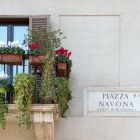Our health in safer hands
It used to be said among foreigners in Rome that in the case of serious illness, the best waiting room in the city was Fiumicino airport. And only recently, an Italian dinner hostess announced that if her clockwork went wrong she would jump in the first taxi for the airport. Was she exaggerating? Or can residents now safely stay put and submit to local ministrations without incurring the risk of an untoward end?
If Italys national health service or Servizio Sanitario Nazionale (SSN), today run by regional governments and no longer by the state, was once panned by the Italian press as universally atrocious (and dangerous), a snap survey of patients and medics seemed to suggest that patches of light are now emerging. Certainly, there still seem to be regular cases of people being sent home after a diagnosis and dropping dead the next day; surgeons still have a propensity to cut off wrong limbs; when, in one hospital, a Scotsman paralysed by two broken legs wished to defecate, his ward had to be cleared because no screens were available; then one unfortunate came round after an operation to discover his testicles missing, apparently a case of mistaken identity.
But cheerier things now happen as well. A British writer in Umbria went for a blood test in Foligno and received the results by e-mail; and your author was pleasantly surprised this year on visits to his local health centre or Azienda Sanitaria Locale (ASL). An X-ray requested by his SSN doctor was taken within ten minutes of his turning up; blood test results were ready in two days; appointments for tests in hospitals were arranged immediately; no more than five people ever stood before him in the queue; and the reception received was of impeccable courtesy.
Health service doctor Maria Luisa Pandolfi agreed, as did some of her patients, that the SSN was slowly improving, but many others judged it extremely bad (malissimo), and her own father, aged 86, had had to wait eight hours in two hospitals to have a morsel of food removed from his throat. The infrastructure is not up to much. Its very variable and a lot depends on being lucky enough to hit on the right place. She confirmed that of Romes hospitals, one of the very worst had always been S. Giovanni-Addolorata, but now, she said, some of its wards, such as cardiology, had shot up to first class.
What is the S. Giovanni-Addolorata hospital complex like today? The blurb calls it a highly specialised hospital chiefly geared to urgent illness. The initial impression, as your author again found out, was reassuring. The reception hall, the two-year-old Sala Mazzoni, was an endless, sparkling, air-conditioned place, where patients clutching a queue ticket awaited their turn on red-upholstered seats, watching for their number to come up on one of four illuminated panels above two long counters staffed by a with-it team of operators. Working from referrals from registered doctors, they quickly booked visits with specialists, tests and out-patient operations, taking prescribed payment, the so-called ticket. The awaited numbers often came up within 15 minutes, and people at welcome desks further down the hall said they had slashed complaints in the 500-bed hospital. Before, people would wander around on their own, get lost and miss appointments, explained an assistant. They would queue up in the wrong line and get furious. Relatives would complain that there was no bell-push by a bed or that nurses wouldnt answer it, or about lack of staff, or doctors being uncivil. If that happens now, we go into the complaint with the doctor in person.
The hospitals Calabria-born director of health facilities, grey-haired Dr Salvatore Passafaro, recognised persistent black spots on its record, despite what he saw as improvements over the past seven years, dating back to the transformation of Italys hospitals into autonomous management bodies or aziende ospedalieri. As everywhere else, were now trying to place emphasis on the quality of what we offer. Our equipment is much more advanced than it was, technologically up to date; were about to open new departments of neurosurgery, ematology and nuclear medicine. Weve increased our intensive care units from eight to 32, cut down the waiting lists, and nurses and doctors now undergo compulsory refresher courses to be rated on a points system.
He candidly owned up to the terrifying images once conjured up by the very name of his hospital and acknowledged that post-operative care was still a bit shoddy. Its a serious problem were dealing with because we first have to revolutionise the frame of mind among staff. As a curious, rather zany example, Dr Passafaro said it was still standard practice to put patients with no need of surgery into surgical wards. Weve got to stop it.
The light-and-dark picture was also painted by Brian Williams, former history lecturer at John Cabot University, operated on this year at the S. Filippo Neri hospital in the northwest of Rome. He recalled: The care I got from surgeons and nurses was excellent. They could not have been more attentive and considerate. But he went on: The hospital infrastructure afterwards turned out to be slovenly, inefficient, careless and discourteous. In the lifts you constantly heard complaints about bad organisation and indifferent staff who did little to ease discomfort. Patients felt they were being treated like cattle.
To register with the Italian national health service EU residents should go to their local national health office (ASL) with all their papers (passport or identity card, permit of stay, fiscal code and work permit). There they will be issued with a health card (tessera sanitaria) and a list of registered doctors in the jurisdiction of the ASL in question. They must then take the card to one of the doctors on the list to register as a patient. Note: this is the usual procedure for EU citizens resident in Italy with all their documents in order. However, it can vary. For confirmation, and to find out what you have to do if you are a non-EU resident or a student, contact the public relations department of ASL Roma A, Via Ariosto 3-9, tel. 0677307215. For addresses and telephones of local ASLs see the telephone directory.





















